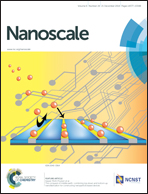Structural evolution from Bi4.2K0.8Fe2O9+δ nanobelts to BiFeO3 nanochains in vacuum and their multiferroic properties†
Abstract
In this paper, we report the structural evolution of Bi4.2K0.8Fe2O9+δ nanobelts to BiFeO3 nanochains and the related variations in multiferroic properties. By using in situ transmission electron microscopy with comprehensive characterization, it was found that the layered perovskite multiferroic Bi4.2K0.8Fe2O9+δ nanobelts were very unstable in a vacuum environment, with Bi being easily removed. Based on this finding, a simple vacuum annealing method was designed which successfully transformed the Bi4.2K0.8Fe2O9+δ nanobelts into one-dimensional BiFeO3 nanochains. Both the Bi4.2K0.8Fe2O9+δ nanobelts and the BiFeO3 nanochains showed multiferroic behavior, with their ferroelectric and ferromagnetic properties clearly established by piezoresponse and magnetic measurements, respectively. Interestingly, the BiFeO3 nanochains had a larger magnetization than the Bi4.2K0.8Fe2O9+δ nanobelts. Moreover, the BiFeO3 nanochains exhibited a surprisingly large exchange bias with small training effects. This one-dimensional BiFeO3 multiferroic nanostructure characterized by a relatively stable exchange bias offers important functionalities that may be attractive for device applications.


 Please wait while we load your content...
Please wait while we load your content...